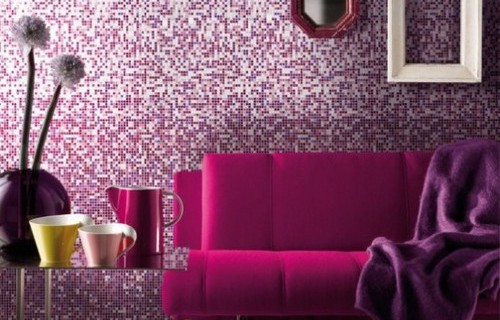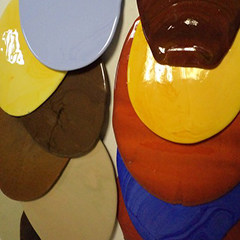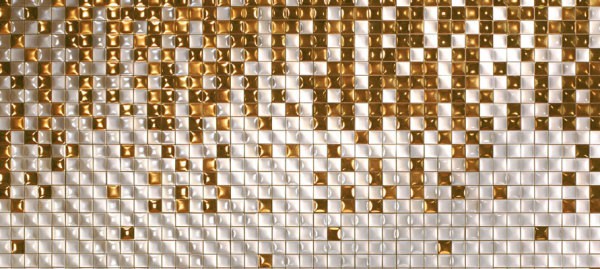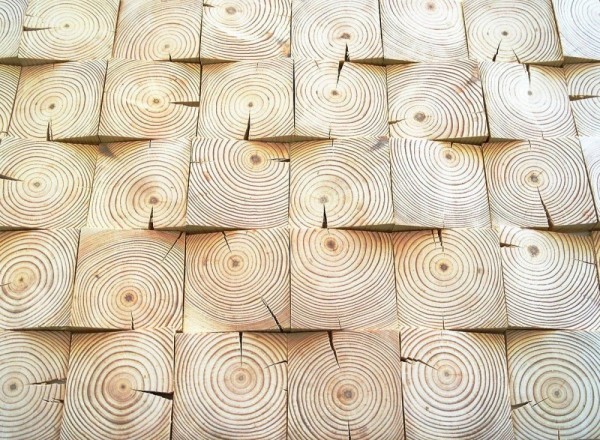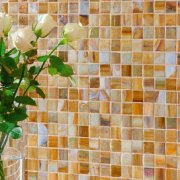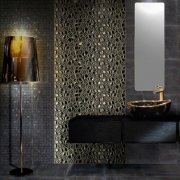Wooden mosaic for walls: where appropriate
An amazing mosaic on the walls can be a patterned drawing made of the same or different solid particles in shape and size. Its individual elements do not carry a semantic load and are only pieces of various materials. How to glue a mosaic on the walls can be found in the proposed article.
The content of the article
Features and types of decorative mosaics
Mosaic is the most ancient way of decorating the interior. It was very often used to decorate palaces, cathedrals, buildings for nobles and nobles.
Currently, it is increasingly used in design in modern interiors and as an addition to ceramic tiles. Art mosaic on the wall is used for interior decoration of any room and for the exterior decoration of the building.
Mosaics can be:
- Glass. The most common type of material. In its manufacture, Venetian glass is usually used, which is resistant to mechanical stress and temperature fluctuations. Glass mosaic walls have:
- water resistant
- resistant to many chemical elements.
Besides:
- the solid structure protects the material from the influence of microorganisms and various bacteria;
- a huge selection of color palette, which is achieved by adding a variety of natural dyes in the production:
- boron;
- cadmium;
- Selene;
- mother of pearl;
- gold;
- aventurine.
Glass mosaic is used for facing:
- bathrooms (see Mosaic decoration of the bathroom - how to do it yourself);
- pools (see Mosaic pool lining: design ideas);
- fountains.
- Smalt. For its manufacture, small particles of colored glass are used, which are pressed and baked for a day at temperatures up to 800 ° C. In this case, the material receives:
- increased abrasion resistance;
- impact resistance;
- frost resistance.
A distinctive feature of smalt is its opacity, but at the same time it emits light as if from the inside. Using modern technology, you can get more than one hundred thousand colors of smalt. In addition, each element of such a mosaic has a shade that allows you to create a unique effect when decorating large areas.
In this case, large sheets of smalt are split with their own hands into individual elements of the necessary shape and size, using a smaltokol. The resulting uneven and rather traumatic edges should be taken into account when choosing a room for decoration and the location of such a work of art.
- Ceramic. This is a ceramic tile, but only smaller. For the manufacture of such mosaics can be used:
- glazed ceramics;
- the most diverse effects that can be: blotches of a different color, stains, craquelure.
The combination of polished and unpolished mosaic looks spectacular; it can be:
- threaded from base plates monoporoses or wall-mounted collection;
- porcelain stoneware or floor collection;
- stick to a mesh or perforated paper backing.
- Stone. For its manufacture, natural natural stone is used:
- marble;
- granite;
- onyx;
- travertine;
- jasper;
- tuff.
Unique, non-repeating color shades and textures of the elements make each panel from such a mosaic unique and original. In this case, the stone is subject to:
- polished;
- polishing;
- Aging
- giving the material the most diverse form.
Stone mosaic is used for facing:
- gender
- fireplaces;
- countertops;
- for the manufacture of decorative inserts in the main background of the mounted tile.
- Metal. It is a sturdy plastic or rubber sheet with a brass or stainless steel face. Mosaic is used for interior decoration in high-tech style. Mosaic made of metal requires special care, due to its exposure to chemicals, temperature extremes, abrasives. A kind of metal mosaic is a mosaic of precious metals, which can be:
- silver;
- gold;
- platinum.
The price of such material is quite high, so the metal mosaic is used as decorative elements.
- Wooden. For its manufacture, valuable wood species of trees are used. A variety of textures, colors and shades of wood allows you to achieve a wooden mosaic of decorativeness and effectiveness.
- Pseudo mosaic. In this case, ordinary tiles are covered with a pattern imitating a mosaic, or grooves are cut on the machines, the thickness of which is equal to the saw blade, they imitate tile joints. In appearance, the tile resembles a real mosaic, and the cost of the material is much lower and it fits like a regular tile.
The advantages of any mosaic material are:
- This is an elite decorative coating, indicating the wealth of the owners.
- Mosaic elements have sufficient strength, are able to withstand the effects of abrasive elements and moisture.
- Simple coating care - just wipe the surface with a damp cloth.
- Elements are not afraid of the chemicals that make up many detergents.
- Drawings made using mosaics can have a unique, inimitable look with patterns of any shades and palette, which allows you to make small dimensions of parts.
- The mosaic is easy to lay on flat and curved walls of any non-standard shape.
- For many years, the coating does not change its original appearance.
- To create the material, broken tiles of different materials are used.
- Before facing the wall does not require its strengthening.
- Mosaic can decorate the room and mask the defects of the existing wall.
- Various colors and textures allow you to break the room into functional zones.
The disadvantages of the material include:
- Small fragments adversely affect the perception of the coating - it begins to ripple in the eyes.
- Fixation of elements should be performed on a special glue.
- Mosaic wall decoration is a long and painstaking work.
- The cost of coverage is more than usual.
How to use mosaic in different rooms
Tip: When choosing such material for the design of any room, one should take into account its purpose. Cannot be used to create a picture on the wall of fabric, straw, beads. All coating elements must be of high strength.
When creating an image in the bathroom, you can get a room that is attractive in appearance and ensure its cleanliness.
Several options for using bathroom linings:
- Multi-colored wall coverings allow you to highlight the area of the washbasin, shower, bath.
- The wall near the washbasin or the bathtub with a mosaic apron looks great.
- A screen arranged under the bath is well decorated with a plain or patterned coating.
- Decoration of the bathroom can be made a mosaic for the mirror.
- The cover perfectly replaces the tiles used to decorate shelves and niches (see How to finish a niche in the wall and in the partition).
- Visually, the window appears larger when decorated with a mosaic rim.
Tip: Do not completely mosaic a small room. In this case, you should create a panel or combine the material with a different type of coating. In a small bathroom you need to use small floral and decorative patterns.
How to lay out the walls in the bathroom with mosaics, what materials and patterns to use on the walls, the video in this article shows in detail. Here you can also get acquainted with the technology of wall decoration from mosaic material.
For the living room:
- A good solution is to place mosaic panels above the fireplace or sofa, which will emphasize the hospitality of the owners.
- The decor of beauty and harmony will help create a panel that looks like a luxurious carpet.
Tip: If you want to clad the entire wall in the living room, you must use elements that will create a flickering effect - a pleasant pearl shine of the coating.
In the hall:
- A plot panel or a mirror lined with mosaics is perfect on the wall (see Mirror panel on the wall: how to use for decoration), as in the photo.
- You can create an unusual atmosphere from small mosaic drawings on the wall.
- Niches, columns, window sills decorated with glass elements look good.
The kitchen must use modern materials that are easily cleaned from any contaminants and counteracting high temperatures.
With the help of such coverage:
- Create kitchen aprons near the sink.
- Functional areas of the room are allocated.
- Small bright drawings are laid out on the walls.
Features of the technology of laying on the walls of wooden mosaics
Such material has several advantages:
- Great for walling with bumps and difficult to level surfaces.
- He is warm.
- Environmentally friendly.
- With a long period of operation.
- When combined with various original and unique ornaments, a sufficiently large multifunctionality is provided.
Wooden mosaic can be of two styles that differ in manufacturing technologies:
- Intarsia. Such a technique when decorating a wooden mosaic is quite laborious and complex. In this case, all individual fragments of it or a set of individual pieces of wood are cut into a wooden base or surface using a wide variety of colors and textures used wood species.
- Marquetry. At the same time, unique and complex mosaic designs or compositions are created by veneer pieces. The creation of the future composition is carried out taking into account the direction of the fibers, color shades and fractal properties of the tree.
A competent selection of wood allows you to give the cladding of mosaics:
- Durability in use.
- Durability.
Tip: Such favorite types of wood as pine and linden cannot be used with mosaic composition.
Hardwoods are used for walls and floors made of wooden mosaics:
- Oak.
- Cedar.
- Ash.
- Maple.
- Alder, in a small amount due to the absorption of negative energy into it, while being a kind of cleaner in nature.
Mosaics can be made from wood waste - chips that are mixed with a mixture of cement and water, after which the mass is given the desired shape, thickness and density.
In this case, the material:
- It has a gray-yellow-orange color.
- Attaches to the surface with glue.
- Folds nicely into a beautiful pattern.
- It has a low cost.
- It has high strength.
- Fire and moisture resistant.
- Soundproof
- Pretty unpretentious in leaving.
When used to protect finished products from wooden mosaics, special impregnations from wax and oils can be laid in the kitchen and in the bathroom.
Tip: You should not cover wooden sections of the walls and floor of a room that are constantly exposed to contact with water.
The technology of laying mosaics made of wood has the following features:
- To simplify installation, sections of wooden mosaics have dimensions of 300x300 millimeters.
- For such material, you can not use ordinary glue.
- When gluing mosaic tiles on plywood, the joining of the sheets should be done diagonally to avoid visible discrepancy of the cladding along the butt joints during thermal deformation of the material.
- When finishing joints, it is not recommended to use ordinary grout, used in the processing of joints between ceramic tiles. In this case, a special two-component epoxy grout is used for grouting joints between hardwoods. This is due to the fact that when grouting ceramic tiles they do not bend and do not deform, but when using wood, from the slightest fluctuations in the material - when the temperature and humidity change, the tree begins to “breathe”, the mineral grout will crack and crumble, and it needs to be washed off plenty of water, which can damage the wooden mosaic.
- The floor is finished with teak mosaic on cork. The thickness of the planks for the floor is 7 millimeters, and for the walls no more than three millimeters. Such a floor should be polished many times, and all butt joints in the floor should be filled with silicone glue.
- The life of the floor is calculated in decades.
- When caring for a wooden mosaic, it is wiped with a damp, and then a dry cloth, every 7 days.
The harmonious combination of the geometry of the patterns and colors of the mosaic elements has not lost its uniqueness and is used for the decoration of residential premises and building facades.
